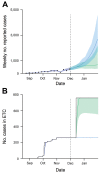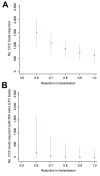Evaluation of the benefits and risks of introducing Ebola community care centers, Sierra Leone
- PMID: 25694150
- PMCID: PMC4344293
- DOI: 10.3201/eid2103.141892
Evaluation of the benefits and risks of introducing Ebola community care centers, Sierra Leone
Abstract
In some parts of western Africa, Ebola treatment centers (ETCs) have reached capacity. Unless capacity is rapidly scaled up, the chance to avoid a generalized Ebola epidemic will soon diminish. The World Health Organization and partners are considering additional Ebola patient care options, including community care centers (CCCs), small, lightly staffed units that could be used to isolate patients outside the home and get them into care sooner than otherwise possible. Using a transmission model, we evaluated the benefits and risks of introducing CCCs into Sierra Leone's Western Area, where most ETCs are at capacity. We found that use of CCCs could lead to a decline in cases, even if virus transmission occurs between CCC patients and the community. However, to prevent CCC amplification of the epidemic, the risk of Ebola virus-negative persons being exposed to virus within CCCs would have to be offset by a reduction in community transmission resulting from CCC use.
Figures




References
-
- Ministry of Health and Sanitation. Ebola virus disease—situation report [cited 2014 Dec 10]. http://Health.gov.sl
-
- Gomes MFC, Pastore y Piontti A, Rossi L, Chao D, Longini I, Halloran ME, et al. Assessing the international spreading risk associated with the 2014 West African Ebola outbreak. PLoS Currents Outbreaks. 2014. Sep 2 [cited 2014 Dec 1]. http://currents.plos.org/outbreaks/article/assessing-the-international-s... - PMC - PubMed
-
- Nishiura H, Chowell G. Early transmission dynamics of Ebola virus disease (EVD), West Africa, March to August 2014. Euro Surveill. 2014;19:20894 . - PubMed
-
- Save The Children. Save the Children opens first Ebola community care centre in Liberia [cited 2014 Dec 1]. http://www.savethechildren.net/article/save-children-opens-first-ebola-c...
Publication types
MeSH terms
Grants and funding
LinkOut - more resources
Full Text Sources
Other Literature Sources
Medical

